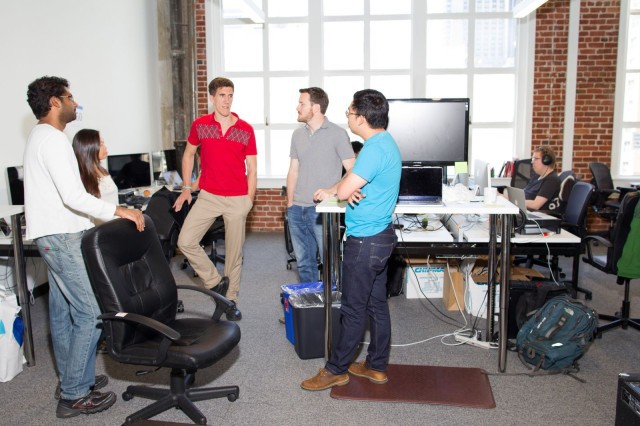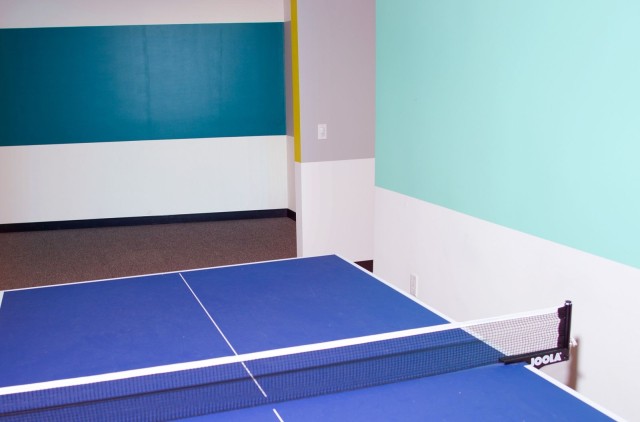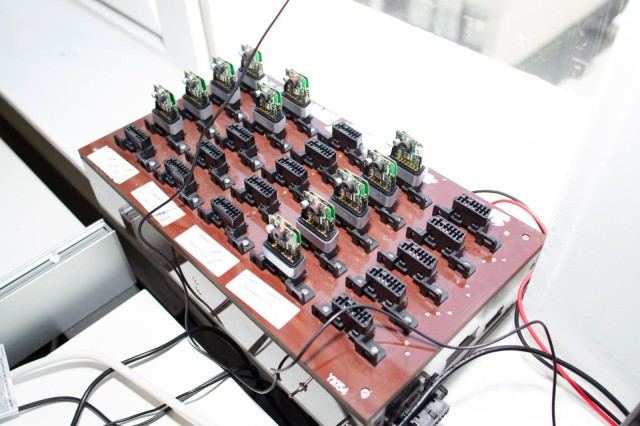SAN FRANCISCO — Brendan Nee is a walking contradiction. He’s car guru who doesn’t own one, a 21st-century geek with an 18th-century mustache who has come up with a novel bit of nagware that could help Americans get off their spreading behinds.
An engineer working on “smart car assistant” Automatic, he spends many of his weekends at hackathons and has a coder’s physique to show for it. In January, he won the Clinton Foundation Code4Health Codeathon by developing a working prototype of an app called Walkoff in just a weekend. A few months later, Nee and team rolled out a more polished version that mashes up the data Automatic pulls from cars with info gathered by a Jawbone Up fitness tracker, showing a user how much time they’re spending behind the wheel versus walking.
“Clearly, without an actual car, I’m not the ideal tester,” admits Nee. The closest he comes to owning a set of wheels is a retired public bus dubbed the PlayaPillar that he only rolls out for Burning Man.
Yet this self-described transportation geek just might be the guy who gets us out of our cars as the wearables arms race revs up. Sales of fitness gadgets like the Jawbone Up, Fitbit and Nike + are expected to more than triple in 2014 over the previous year, leaving us with 19 million trackers and trainers strapped to our wrists. Analysts expect that number to hit 111.9 million gadgets by 2019, but the speed bump on the road to victory, they say, is the smart accessory segment, which is “not quite ready for prime time.” Alas, the current generation of dongles and smart-ish watches can’t really harness the power of third-party data or APIs.
The Jawbone Up and Automatic data mashup is the kind of thing that could push things forward before Apple gets in with its health-conscious iWatch. If Nee can nudge you to see how frequently you’re driving short distances, that knowledge might inspire you to substitute walking on your next trip of a mile or two.
After a simple setup process, Automatic pushes driving data to the driver’s Jawbone Up, which already logs the user’s steps, mood, sleep, physical activities and other personal stats. “People spend a lot of time behind the wheel without even realizing it, but now you can see your driving data overlaid on the rest of your day,” Nee says.
He spends a lot of time figuring how to get the rest of us from point A to point B without four wheels.
“One way of giving up is to just buy a car,” he says. “If you live in the suburbs and you have a garage, buying a car is subsidized in so many ways. We live in an environment that is basically paying you to drive everywhere.”

Nag, nag, nag
There could be a downside to your gadgets putting their virtual heads together: Will they nag you incessantly to get a move on? Nee says the team at Automatic took care to use neutral language and focus on the nuts and bolts.
“We kept the judgment out of it,” he says. “We wanted to make it very matter-of-fact, not naggy or opinionated.”
For each short trip, the overlay points out how many steps user would have taken if they had walked instead of driving, then lets them come to their own conclusions. “Also, we looked into the maps, making sure they work well in urban and suburban environments,” Nee says. “We don’t want to press you to walk where there are no sidewalks.”
This could change in the future. Since you can already set Jawbone Up to buzz after an interval of inactivity, it can give you a nudge while you’re in the driver’s seat that maybe you could’ve gone for a stroll instead. The day where a car computer like KITT — equipped with a dry sense of humor and a mid-Atlantic accent, occasionally petulant and sometimes off the rails— starts running the show may not be that far off.

Walk Score: halfway there
Examples from Nee’s own iPhone show him walking just 4,000 steps in a day — less than half the standard, if arbitrary, goal of 10,000 — yet driving 26 miles. There’s definitely room for improving his own habits, he admits. Nee lives with eight roommates in San Francisco’s trendy Mission District, where he has a front seat to transport protests about the Google buses. To get to Automatic’s nondescript offices near Union Square, he alternates between BART trains, a bike and taxi alternative Uber.
All employees at Automatic get behind the wheel with one of the company’s Automatic Link dongles so they can see firsthand how it works. Fortunately for the car-free Nee, the dongle fits into any OBD II port, connecting quickly to the on-board diagnostics system standard on cars and trucks sold in the United States after 1996. So Nee cajoles the drivers of services like Uber to plug in the Automatic Link so he can track the miles he spends sitting on a cushy back seat instead of hoofing it.
Even without his own wheels, Nee’s transportation geekery is almost boundless. Side projects include Google hackathon winner Walksy, which generates walking tours that start anywhere, and Bikesy, which spins bike routes for the Bay Area from OpenStreetMap data. He’s so into car-sharing services — almost more plentiful than the city’s iconic cable cars these days — that he built a cost-comparison website. Automatic’s gizmo works in these cars, too, he notes.
Sitting in the Ikea-cheerful dining room at Automatic’s HQ, Nee gives an extemporaneous rundown of various car-sharing services — which ones are cheaper by the mile, or by the the hour — then lets me in on one I hadn’t heard of before imploring me to keep it secret. (“Right now, there’s always availability, and it’s pretty inexpensive,” he says.)
When it comes to using the city’s much-maligned MUNI public transit system, he’s got a great hack for that: In his house, Nee hooked up a Raspberry Pi to a monitor to show the routes he takes most often so he can see at a glance whether he’ll have to wait another 25 minutes for his usual 12-minute commute. “Everyone can have an app — you can pull it out of your pocket and type in where you’re going. But having it on the wall skips a step: You can make a split-second decision, and maybe take Uber instead,” he says, adding that a Pi and an old monitor are a lot cheaper than a tablet.
Americans’ rapidly expanding waistlines are linked to a growing reliance on cars and tied to income levels. Getting started on the Jawbone and Automatic nudge system is not a cheap fix: You’ll need the Jawbone wristband ($129-149), a smartphone (iPhone or Android), a reasonably late-model car and, last but not least, Automatic’s dongle ($100). Does Nee worry that the cost could put the concept out of reach of the people who might need it most?
“This isn’t solving whole obesity problem,” he says. “There are a lot of people who mainly drive for short trips and don’t have the opportunity to walk instead, but there are strategies for them.” Parking at the far end of the parking lot during the next trip to a big-box store can mean getting a quarter-mile walk each way, he notes.
“Most people can find ways to get in extra steps, even if it’s not the most walking-friendly environment,” he says. “They can realize it may not be fun, but as long as it’s safe, they’ll do it.”



